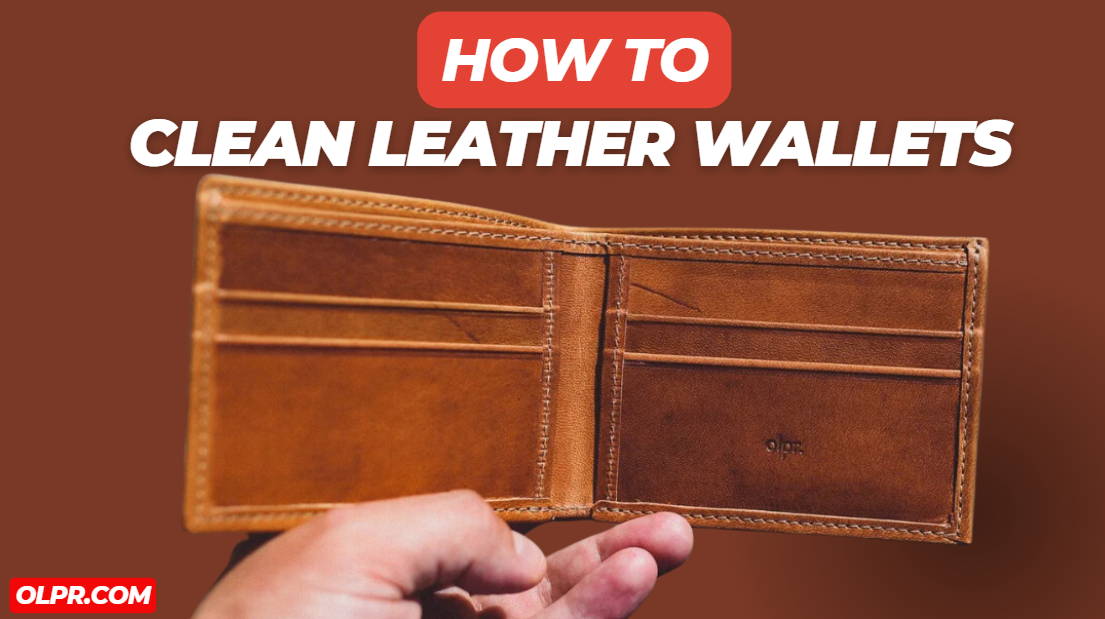
Leather is a durable material that has been around for a very long time and is used to make many things, such as bags, wallets, and even journals. If you have been wondering how to clean leather wallets, you have come to the right place, as this article outlines all you need to know.
Your leather wallet is an accessory that always stays with you as you use it often. It holds all your necessary items and daily essentials. Your wallet will pick up stains and dirt after a long time without washing.
Cleaning leather wallets is necessary for maintenance, especially before you apply new treatments and finishes. There are ways you can do this effectively and safely.
Since leather wallets are designed for durability, they will maintain their lovely appearance for many years, provided you maintain them. Leather wallets cannot be put in the washing machine for cleaning – they need special care if you want to keep their beautiful appearance.
A proper cleaning routine is needed if you want to remove all the dirt and extend the life of your leather wallet. Before we go into the steps you should take when cleaning your leather wallet, let us look at what gets a leather wallet dirty in the first place.
Why Does My Leather Wallet Get Dirty?
Many people need to learn that they are meant to clean their leather wallets from time to time if they want them to last long. They take it out for the whole day and dump it somewhere when they come back. Then, they complete this process for months or even years.
Leather can last for a lifetime if it is taken care of properly. But the major question here is why leather wallets get dirty. Your leather wallet will inevitably pick up dirt and stains after years of use.
Leather is a porous material – it absorbs oil and moisture from every surface it comes in contact with. Since our skin produces oil – some more than others – our leather wallets will absorb the oil from our palms when we touch them many times a day.
Your leather wallet absorbing oil from your palms is not bad, as it helps increase longevity. But it does have a disadvantage – the oil attracts dirt. For example, after a long day of touching your wallet, you return and place it on the table. The oil on the wallet will attract the dirt on the table.
As you continue using your wallet and repeat the same process every day, your leather wallet will become very dirty. After some time, the surface of your wallet will no longer have its natural color and shine. This is why cleaning is important, as it will help extend your leather wallet's life.
Different Types of Leather
When cleaning your leather wallet, you need to consider the type of leather you are dealing with, as this determines the cleaning method. Knowing the kind of leather you are working with will help you to decide whether to use alcohol or soap.
Also, leather is susceptible, especially when applying acids and solvents. So you need to read through the list of ingredients for any solution you want. This way, you can tell if it is suitable for the kind of leather you have.
There are three main types of leather your wallet could be made of synthetic, natural, and vegetable-based. Natural leather is not synthetically made – it is made from animal skin. Cowhide is commonly used but can also be made from goat, alligator, buffalo, etc.
Vegetable-based leather is made from plants like cotton, as the name implies. They are flexible and soft materials but absorb oil and stains easily. Synthetic leather is made from nylon, polyester, vinyl, or acrylic. They are often used to make shoes because they are hard, water-resistant, and durable.
Before you clean your leather wallet, check the label to know what kind of leather you are dealing with. If the type of leather is not stated there, you need to feel the surface of your wallet to know what kind it is. If it is genuine leather, there is a high chance that you are dealing with natural animal hide.
Once you know the kind of leather you are working with, you can decide to clean it yourself or get someone to do the work for you.
If it has a smooth surface, it is probably synthetic leather. If it has a rough surface, there is a high chance that it is not vegetable-based leather.
Nubuck and suede leather are stain-resistant because of the type of texture they have. So, if your wallet is made from this type of leather, you may not need to clean it. Your wallet will require extra care if it is made from synthetic leather and has not been cleaned.
How to Clean a Wallet
# 1. Remove the Items in Your Wallet for Cleaning
Before you start cleaning, you need to remove everything inside the purse. You don't want anything to get wet, so take everything out; don't leave anything in it.
While you are emptying your wallet, you can go through the different items and throw out the unnecessary ones that are taking up space.
Once you are done sorting, store the essentials in a safe place until your wallet is washed and dried. This way, your purse will be thin once you complete the cleaning process described below.
# 2. Check the Different Types of Stains
Stains come in different types: there are simple and stubborn ones, and if you want to remove them, you need to identify them first. So, the next step after emptying your wallet is to identify the different types of stains on it.
Some stains can be removed completely, while others cannot. You may need to focus on cleaning to the best of your ability. Your leather wallet will still look new and fresh even if you can't remove all the stains.
As stated above, leather is a porous material that absorbs oil easily. For this reason, the most common type of stains on leather is dirt attracted by oily fibers. If you have used your wallet for a long time and it is made of genuine or natural leather, there is a good chance that patina has formed on the corners.
Patina is a layer (dark in color) that forms on the surface of leather or genuine leather as the leather ages. The patina layer will look like dirt if you are not familiar with aging leather. But once you clean your leather wallet, the patina layer will look amazing.
Another type of stain that can be found on a leather wallet is ink from the pocket. These stains usually don't go away, but if you put a lot of effort, you might get lucky.
# 3. Clean Stains with Alcohol or Soap and Water
Once you have identified the stains on your wallet, the next step is to clean them using soap and warm water or by rubbing alcohol on them. This depends on the degree of stains on the wallet. You use soap and water for minor stains and alcohol for difficult stains like ink or paint.
DO NOT Wet Your Wallet With Alcohol!
DO NOT Wet Your Wallet With Soap!
Alcohol is an anti-bacterial agent and a great one at that, so it will do an excellent job of killing the bacteria and viruses on the leather surface. To start, you should mix unscented soap in a bowl of slightly warm water (you can use unscented shampoo if you do not have soap).
Gently wipe the surface of your wallet to clean it. You should start from one side of the wallet – dip the cloth into your cleaning solution and wipe gently in a circular motion.
1. Lightly Wet a Cloth or Sponge.
2. Use the Cloth or Sponge to Wipe the Shelf with the Wet Cloth or Sponge.
Next, You Should Get a Soft Cloth (Microfiber) for Cleaning and Another for Drying.
Remember to wipe the edges of your leather wallet. Move from one edge to the other slowly until you have cleaned off all the dirt (oil or grease) on the surface. You should also clean inside your wallet – the pockets and inner sides.
Once you are done, rinse the wallet under running tap water. Note that you can use a nail polish remover instead of alcohol for stubborn stains.
# 4. Air-Dry Your Leather Wallet
You should never place your leather wallet under direct sunlight for it to dry, as this will damage it. Instead, you can use a lint-free cloth to wipe the wallet. You can also wrap the wallet in a clean hand towel and store it in a well-ventilated area for at least twelve hours.
You can also wrap your moist wallet with tissue paper and place it in a well-ventilated area for 12 hours. The dry air will take out all the moisture in your wallet.
# 5. Use a Conditioner (Protective Finish)
Once your leather wallet is dry, you should add a protective finish to restore its shine. You can get a leather cleaner or leather conditioner from any online store.
Some of these products contain oils and waxes that prevent the leather from absorbing moisture by sealing it.
All you need to do is apply a thin, even layer of the conditioner on every surface you clean and leave it for about ten minutes. Then, clean it with a clean cloth.
How to Clean a Leather Wallet with Lemon Juice or Cream of Tartar
The first thing you need to do is mix equal parts of both choices into a paste. Then, apply that paste onto the stained areas and let it sit for thirty minutes. Once thirty minutes are up, use a damp cloth to remove the paste. Not that you should only use this method on lightly colored leather as it has a bleaching effect.
Frequently Asked Questions (FAQs)
How do I clean and shine my leather wallet?
You can use soap and water for minor stains and alcohol or nail polish remover for stubborn stains. Once you are done, apply leather conditioner and massage it into your leather wallet to achieve that shine.
How to clean leather wallet without cleaner?
You can use baby soap or mild shampoo if you do not have leather cleaner. Apply these two products to a damp cloth and dab them onto the wallet.
Is it possible to wash a leather wallet?
You can wash a leather wallet, but you should never use a washing machine. Hand wash is advisable.
How do you condition a leather wallet?
Apply your conditioner to every surface you clean and let it sit for about ten minutes.
Conclusion
Leather is a beautiful and durable material that becomes more stunning with age. To get the most out of your leather wallet – functionality and beauty – you need to maintain it at all times. This involves cleaning it once in a while and doing it the right way.
You can check the olpr. website for classic handmade leather wallets if you want to add more to your collection.
